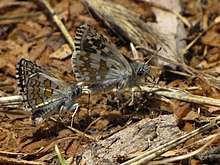Safflower skipper
The safflower skipper (Pyrgus carthami) butterfly is a species of skipper butterfly (family Hesperiidae).
| Safflower skipper | |
|---|---|
| Pyrgus carthami, upperside | |
 | |
| Pyrgus sidae and Pyrgus carthami, underside | |
| Scientific classification | |
| Kingdom: | Animalia |
| Phylum: | Arthropoda |
| Class: | Insecta |
| Order: | Lepidoptera |
| Family: | Hesperiidae |
| Genus: | Pyrgus |
| Species: | P. carthami |
| Binomial name | |
| Pyrgus carthami (Hübner, 1813) | |
| Synonyms[1] | |
|
List
| |
Subspecies
Distribution and habitat
This species is a widespread in Southern and Central Europe, Asia Minor, Russia and Central Asia. It is absent from North Africa, peninsular Italy, northern France, the British Isles and Scandinavia.[4][5] It frequents dry, sunny slopes, clearings, meadows and other grassy places, from sea level to 1900 m. In some parts of its range, it is fairly common.
Description

The wingspan is 30–34 mm, the female being on average slightly larger than the male. This species is typical of the genus and it is the largest European Pyrgus. The upperside of the wings is grayish brown. On the upperside of the forewing there are a basal gray and white fringe of hair and variables quadrangular white patches, with a cell spot in the form of a Greek capital sigma. The upperside hindwing shows a submarginal line of white spots and a postdiscal line of oval whitish spots. The underside of the forewings is lighter, greenish-brown with white markings, while in the hindwings there are large brown and white patches bordered with dark grey and a white submarginal area.[6] The caterpillar is mainly olive-brown to beige with a blackish chest.
This species is rather similar to Pyrgus alveus, Pyrgus armoricanus, Pyrgus serratulae and Pyrgus malvae. It can be difficult to separate this species from its congeners. It is most often confused with the large grizzled skipper (P. alveus) as the two species are often found in similar habitats. P. carthami can usually be separated from this species by the more closely grouped white spots on the forewing and a band of evenly sized pale spots in the postdiscal area of the hindwing.
Biology
A single generation is produced each year. It overwinters in the caterpillar stage. The larvae feed on Alcea, Malva sylvestris, Potentilla pedata, Potentilla neumanniana, Potentilla argentea, Althaea officinalis, Althea hirsuta and Centaurea species.[4] It pupates in rolled leaves of host plants or on the ground. The pupal stage last up to 14 days. The adult is on the wing from June until September.
References
Bibliography
- Whalley, Paul - Mitchell Beazley Guide to Butterflies (1981, reprinted 1992) ISBN 0-85533-348-0
- Tom Tolman et Richard Lewington, Guide des papillons d'Europe et d'Afrique du Nord, Delachaux et Niestlé, 1997 (ISBN 978-2-603-01649-7)
- De Jong, R. 1972. Systematics and geographic history of the genus Pyrgus in the palearctic region (Lep., Hesp.). Tidjschrift voor Entomologie, 115(1): 1-120.
External links
- Lepiforum.de
- Butterfly Guide
- Paolo Mazzei, Daniel Morel, Raniero Panfili Moths and Butterflies of Europe and North Africa
- Butterflies of Bulgaria